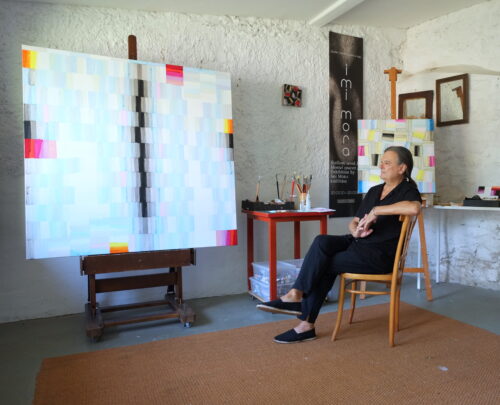
English
Mental Spaces II. – Imi Mora’s exhibition
FUGA Architecture Center, Budapest 2020
Imi Mora (b. 1953) graduated from the Hungarian School of Fine and Applied Arts in Budapest as a painter(1972), then continued his studies at the Hungarian University of Fine Arts, where he graduated as a painter-restorer in 1979. He began his career as a restorer, lived and worked in Germany for 20 years. In 2005, he decided to create freely. He settled in Austria, and has lived and worked there and at Lake Balaton ever since.
He created many autonomous artworks even as a restorer. He organized his first solo exhibition in 1989 at the Bavarian BBK, and from then on he participated in the exhibitions of the Munich “Artists’Gallery” every year. He is a member of the Bayerischer Berufsverband bildender Künstler art organization, the Austrian Association of Visual Artists, and the Hungarian MAOE. He has participated in numerous group exhibitions in Hungary, most recently in the Bauhaus 100 exhibition organized by OSAS at the Vasarely Museum Budapest, but in the last decade he has been increasingly appearing in international thematic exhibitions and is regularly present at Austrian group exhibitions and at the Vienna Art Fair. He is interested in the creation of the artwork, the process of creation, being emerged in the artwork and capturing the totality of the spiritual-physical-aesthetic space considered the essence of life and its expression with minimal means.
Imi Mora works with brush, oil paint, charcoal and ink. For him, creation is a ritual, in which the artwork is born with movement and via a dialogue with the materials. The process culminates in a dynamic, open space that evokes ceaseless movement, transformation, and change. This effect is achieved through the rhythmic repetition of the chosen visual element, utilizing both impasto texture and translucent glazing, along with the careful layering, condensing, and thinning of these elements. The artist is preoccupied with the complexity of life: specifically, the transformation of movement, color, and substance into a synesthetic experience (linking color, music, and dance) and, equivalently, into a saturated, mostly harmonious form and reality-relationship between the geometric and the organic.
His compositions are usually textures built from a single motif – dot, spot, brushstroke – which he partly frees from the burden of physicality and partly embodies in a plastic way, e.g. the brushstroke in his paintings is the basic element of painting, the main motif of the composition, and at the same time a gesture saturated with actuality created with lighter or stronger pressure. In his artworks, he consciously builds the structure, but the form develops freely and, despite its volatility, preserves the image and moments of the physical quality of material and movement and the presence. He names his paintings “Fieldwork”, a term that signifies his act of broadening the finite field of consciousness and sensation into a cosmic one, and as the Viennese gallerist Thomas Mark noted, he transforms these fields into mystical spaces.
Júlia N.Mészáros, art historian
Magyar
Szellemi terek II. – Imi Mora kiállítása
FUGA, Építészeti Központ, Budapest 2020
Imi Mora (sz. 1953) a budapesti Magyar Képző- és Iparművészeti Szakközépiskola festő szakán érettségizett (1972), majd a Magyar Képzőművészeti Egyetemen folytatta tanulmányait, ahol 1979-ben festőrestaurátor művészként végzett. Pályáját restaurátorként kezdte, 20 évig Németországban élt és dolgozott. 2005-ben a szabad alkotás mellett döntött. Ausztriában telepedett le, s azóta ott, és a Balatonnál él és dolgozik.
Már restaurátorként is sok autonóm művet alkotott. Első önálló kiállítását 1989-ben a bajor BBK-ban rendezte, s attól kezdve minden évben részt vett a Müncheni Alkotók Galériája tárlatain. Tagja a Bayerischer Berufsverband bildender Kunst művészeti szervezetnek, az Osztrák Képzőművészek Egyesületének és a MAOE-nek. Magyarországon számos csoportos kiállításon vett részt, legutóbb az OSAS által szervezett Bauhaus 100 című tárlaton, a Vasarely Múzeumban, de az utóbbi évtizedben egyre gyakrabban szerepel nemzetközi tematikus kiállításokon és rendszeresen jelen van osztrák csoportos tárlatokon, valamint a bécsi Művészeti Vásáron. A mű keletkezése, az alkotás folyamata, a műben való benne levés és az élet lényegének tekintett szellemi-fizikai-esztétikai tér totalitásának a megragadása és minimális eszközökkel való kifejezése érdekli.
Imi Mora ecsettel, olajfestékkel, szénnel és tussal dolgozik. Számára az alkotás rítus, amelyben a mű mozgással és az anyaggal való párbeszédben születik meg. A folyamat végén szüntelen mozgás, átalakulás, változás képét gerjesztő, élő, nyitott tér jön létre a választott vizuális formaelem pasztózus és lazúrosan áttetsző, ritmikus ismétlésével, az elemek sűrítésével, ritkításával és egymásra fedésével. A művészt az élet összetettsége foglalkoztatja: a mozgás, a szín és az anyag átlényegítése szinesztétikus érzetté (szín, zene, tánc) és azzal ekvivalens, a geometrikus és organikus közötti, telített, többnyire harmonikus formává és valóság-viszonnyá.
Kompozíciói általában egyetlen motívumból – pont, folt, ecsetnyom – épített textúrák, amelyeket részben megszabadít a fizikaiság terhétől, részben pedig plasztikussá testesít, pl. az ecsetnyom a képein a festés alapeleme, a kompozíció fő motívuma, egyúttal könnyed vagy erősebb nyomással létrehozott, aktualitással telített gesztus is. Alkotásaiban a szerkezetet tudatosan építi, a forma azonban szabadon alakul, és az illékonyság ellenére megőrzi az anyag és mozgás fizikai minőségének és a jelenvalóságnak a képzetét és mozzanatait. Képeit Fieldwork-nek nevezi, ami azt jelenti, hogy kozmikussá tágítja a tudat és az érzet behatárolt mezejét, és ahogyan Thomas Mark bécsi galérista mondta, misztikus terekké alakítja.
Mészáros Júlia művészettörténész